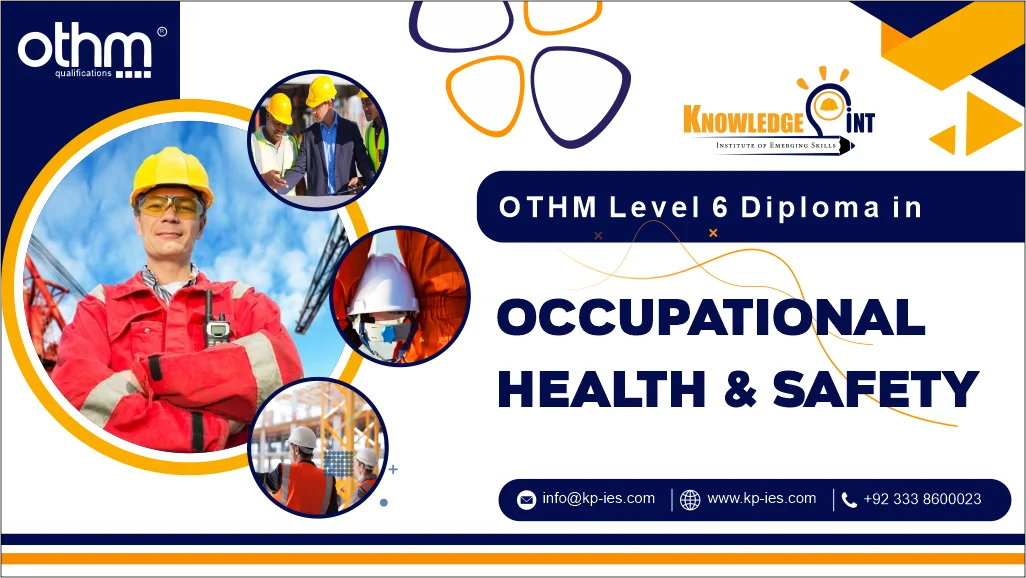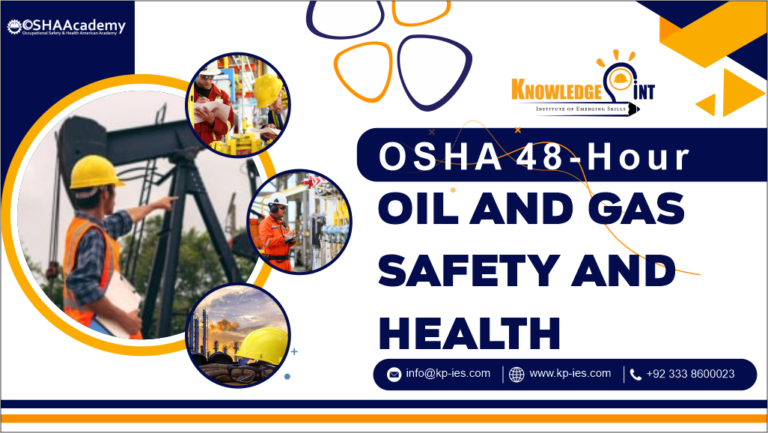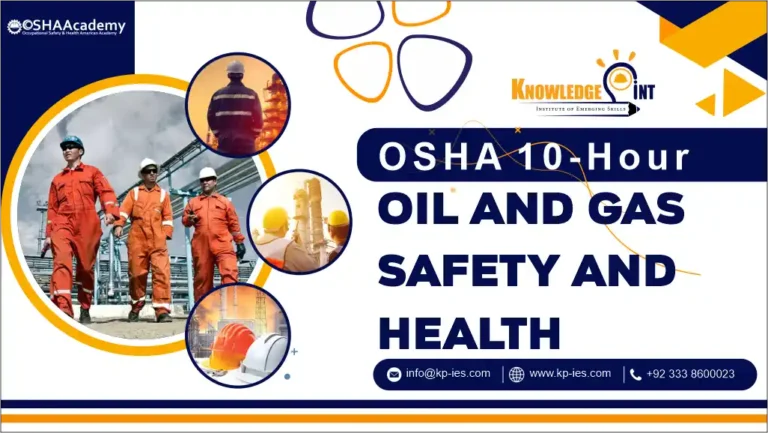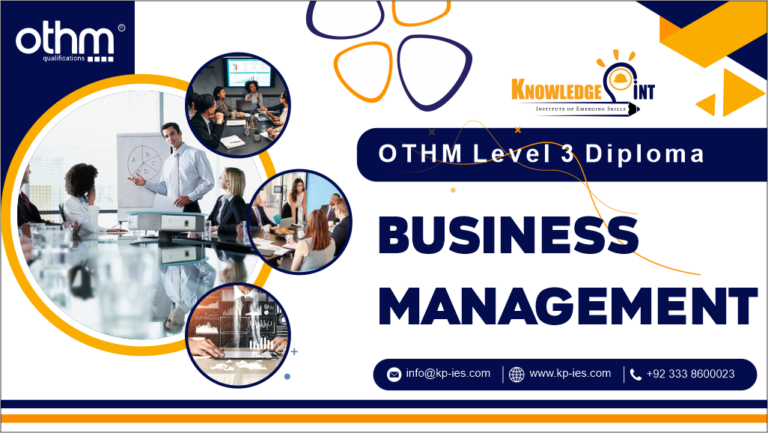In the dynamic landscape of occupational health and safety, staying ahead of the curve is crucial for professionals aiming to make a significant impact in their careers. One avenue that stands out for those looking to enhance their expertise in this field is the OTHM Level 6 Diploma in Occupational Health and Safety. This qualification not only provides a comprehensive understanding of occupational health and safety principles but also equips individuals with the skills needed to navigate the complex challenges of today’s workplace environment.
OTHM places a strong emphasis on practical application, ensuring that students not only grasp theoretical concepts but also acquire the skills necessary to implement them in real-world scenarios. This hands-on approach prepares graduates to face the challenges of the workplace with confidence. OTHM Level 6 Diploma holds international recognition, making it a valuable asset for professionals seeking career opportunities on a global scale. The program is designed to align with international standards, providing graduates with a competitive edge in the job market.
OTHM Level 6 Diploma in Occupational Health and Safety is a globally recognized qualification designed to cater to the needs of professionals aspiring to excel in occupational health and safety roles. Accredited by recognized awarding bodies, this diploma program is structured to offer a balance between theoretical knowledge and practical skills, ensuring that graduates are well-prepared to meet the demands of the industry.
The OTHM Level 6 Diploma in Occupational Health and Safety is more than a qualification; it’s a gateway to a fulfilling and impactful career. Whether you are a seasoned professional or just starting in the field, this program provides the knowledge, skills, and recognition needed to excel in the dynamic and ever-evolving realm of occupational health and safety. Enroll today and take the first step toward a safer, healthier, and more successful future in the world of work.
Course Overview
OTHM Level 6 Diploma in Occupational Health and Safety Consist of
Upon successful completion of the OTHM Level 6 Diploma in Occupational Health and Safety, learners will be equipped with the knowledge, skills, and abilities to:
- Demonstrate In-Depth Understanding: Articulate a comprehensive understanding of the principles, theories, and key concepts related to occupational health and safety, including risk management, hazard identification, and regulatory compliance.
- Apply Legislation and Standards: Apply relevant national and international occupational health and safety legislation and standards to assess and manage workplace risks effectively, ensuring legal compliance and a safe working environment.
- Conduct Effective Risk Assessments: Conduct thorough and systematic risk assessments, identifying potential hazards, evaluating risks, and implementing control measures to mitigate and manage occupational health and safety risks in diverse workplace settings.
- Develop and Implement Safety Policies: Develop, implement, and evaluate occupational health and safety policies and procedures, demonstrating the ability to align organizational goals with safety objectives and promoting a culture of safety within the workplace.
- Lead Incident Investigation: Lead and participate in incident investigations, applying systematic methodologies to identify root causes, contributing factors, and trends, and recommending corrective and preventive actions to enhance workplace safety.
- Design and Implement Health Promotion Initiatives: Develop and implement workplace health promotion initiatives, considering physical, mental, and social well-being, and fostering a culture of health and wellness among employees to enhance overall workplace satisfaction.
- Manage Emergency Preparedness and Response: Develop and manage emergency preparedness and response plans, ensuring the organization’s ability to respond effectively to emergencies, accidents, and unforeseen events, minimizing potential harm to employees and the workplace.
- Evaluate and Enhance Safety Culture: Assess and enhance organizational safety culture by implementing strategies to engage employees, foster open communication, and promote a proactive approach to safety, creating an environment where safety is a shared responsibility.
- Utilize Ergonomic Principles: Apply ergonomic principles to design and assess workspaces, equipment, and processes, promoting the well-being of employees by minimizing the risk of musculoskeletal disorders and optimizing overall efficiency.
- Employ Effective Communication Skills: Demonstrate effective communication skills to convey complex occupational health and safety information clearly and persuasively to diverse stakeholders, fostering collaboration and understanding across different levels of the organization.
- Lead Continuous Improvement Initiatives: Drive continuous improvement in occupational health and safety performance by monitoring and analyzing key performance indicators, implementing corrective actions, and adapting strategies to evolving workplace conditions and industry best practices.
- Navigate Ethical Dilemmas: Analyze and navigate ethical dilemmas in the field of occupational health and safety, demonstrating the ability to make informed decisions that prioritize the well-being of individuals and the organization while upholding ethical standards and integrity.
These learning outcomes collectively prepare learners to excel in occupational health and safety management roles, making meaningful contributions to workplace safety and employee well-being.
Enrolling in the OTHM Level 6 Diploma in Occupational Health and Safety offers participants a myriad of benefits, positioning them for success in the dynamic field of occupational health and safety. The course benefits include:
- Comprehensive Knowledge Base: Gain an in-depth understanding of occupational health and safety principles, legislation, and best practices, providing a solid foundation for effective decision-making and management in the workplace.
- Enhanced Career Opportunities: Open doors to a wide range of career opportunities in occupational health and safety management, allowing participants to pursue leadership roles and advance their careers in various industries globally.
- Global Recognition: Attain a globally recognized qualification, enhancing credibility and employability on an international scale. The OTHM Level 6 Diploma is respected by employers worldwide, providing a competitive edge in the job market.
- Practical Application of Knowledge: Acquire practical skills to apply theoretical knowledge in real-world scenarios, ensuring graduates are well-prepared to address workplace challenges and contribute to the development of effective safety measures.
- Risk Management Expertise: Develop expertise in risk management, enabling participants to identify, assess, and manage occupational health and safety risks proactively, ultimately reducing workplace incidents and enhancing overall safety.
- Leadership Skills Development: Cultivate leadership skills necessary for managing occupational health and safety initiatives within an organization, including policy development, incident investigation, and fostering a safety-conscious culture.
- Emergency Preparedness and Response: Learn to develop and implement effective emergency preparedness and response plans, ensuring a quick and efficient response to unforeseen events, accidents, and emergencies within the workplace.
- Health Promotion Initiatives: Gain the skills to design and implement health promotion initiatives, contributing to the overall well-being of employees and creating a positive work environment that values and prioritizes employee health.
- Continuous Improvement Focus: Develop a mindset of continuous improvement, with the ability to monitor key performance indicators, analyze trends, and implement corrective actions to enhance occupational health and safety performance over time.
- Networking Opportunities: Connect with professionals in the field, fellow course participants, and industry experts, creating valuable networking opportunities that can lead to collaborations, mentorships, and exposure to diverse perspectives within the occupational health and safety community.
- Flexibility in Learning: Benefit from flexible learning options, including online and part-time study modes, accommodating the diverse needs and schedules of working professionals seeking to advance their education while maintaining their current commitments.
- Positive Impact on Workplace Culture: Make a positive impact on workplace culture by instilling a safety-conscious mindset and promoting a collaborative approach to occupational health and safety, fostering a work environment where employees feel valued and protected.
The OTHM Level 6 Diploma in Occupational Health and Safety offers a comprehensive and globally recognized education, equipping participants with the knowledge and skills needed to thrive in the field and make a significant impact on workplace safety and well-being.
OTHM Level 6 Diploma in Occupational Health and Safety consists of following 10 mandatory units.
| Sr# | Unit Title | GLH | TQT |
|---|---|---|---|
| 1 | Health and Safety Management Principles and Policy | 30 | 80 |
| 2 | Health and Safety Management Practice | 40 | 100 |
| 3 | Risk and Incident Management | 30 | 80 |
| 4 | Promoting a Positive Health and Safety Culture | 20 | 60 |
The OTHM Level 6 Diploma in Occupational Health and Safety serves as a stepping stone for individuals looking to further advance their careers and expertise in the field. The future progression for participants who successfully complete this course includes:
- Advanced Studies and Specializations: Graduates can pursue advanced studies by enrolling in postgraduate programs related to occupational health and safety. Specialized courses can focus on specific areas such as environmental health, industrial hygiene, or safety management, allowing individuals to deepen their knowledge in a particular field.
- Professional Certifications: Acquiring additional professional certifications is a common path for career progression. Individuals can pursue certifications from recognized bodies such as the Board of Certified Safety Professionals (BCSP), the International Institute of Risk and Safety Management (IIRSM), or other relevant organizations to further enhance their credentials.
- Membership in Professional Associations: Joining professional associations in the occupational health and safety field provides opportunities for networking, continued learning, and staying updated on industry trends. Associations such as the Institution of Occupational Safety and Health (IOSH) and the American Society of Safety Professionals (ASSP) offer memberships that can support ongoing professional development.
- Leadership Roles and Management Positions: Armed with the knowledge and skills gained from the diploma, individuals are well-positioned to take on leadership roles within organizations. They can aspire to become Occupational Health and Safety Managers, Directors, or even Chief Safety Officers, overseeing comprehensive safety programs and strategies.
- Consultancy and Advisory Roles: Experienced professionals may choose to leverage their expertise by offering consultancy services. They can provide advisory services to organizations looking to enhance their occupational health and safety practices, develop policies, and ensure compliance with regulations.
- Research and Publications: For those interested in contributing to the academic and research aspects of occupational health and safety, pursuing a career in research or academia is a viable option. Graduates can engage in research projects, publish articles, and contribute to advancements in the field.
- International Opportunities: The global recognition of the OTHM Level 6 Diploma opens doors to international opportunities. Graduates can explore job opportunities in different countries, collaborate on global projects, and contribute to international initiatives related to occupational health and safety.
- Entrepreneurship: Some individuals may choose to establish their own occupational health and safety consulting firms or businesses. This entrepreneurial path allows them to apply their knowledge and skills in a self-directed manner, providing services to a diverse range of clients.
- Continuous Professional Development (CPD): Engaging in continuous professional development is essential for staying current in the ever-evolving field of occupational health and safety. Graduates can attend workshops, conferences, and seminars, and participate in online courses to ensure they remain at the forefront of industry trends and best practices.
- Mentoring and Training: Experienced professionals can take on mentoring roles to guide and support aspiring individuals in the field. They may also become trainers, sharing their knowledge and insights by conducting workshops and training sessions for organizations or educational institutions.
The OTHM Level 6 Diploma in Occupational Health and Safety provides a solid foundation for diverse career paths and continuous professional development. Whether individuals choose to specialize, pursue leadership roles, contribute to research, or embark on entrepreneurial ventures, this diploma serves as a catalyst for long-term success in the field of occupational health and safety.
Entry Requirements
The entry requirements for the OTHM Level 6 Diploma in Occupational Health and Safety typically include the following criteria:
- Educational Background: Applicants are expected to have a relevant academic background, usually a bachelor’s degree or an equivalent qualification from a recognized institution. The degree may be in areas such as occupational health, safety management, environmental health, or a related field.
- Work Experience: Many institutions offering the OTHM Level 6 Diploma prefer applicants with relevant work experience in the field of occupational health and safety.
- English Language Proficiency: Since the course is conducted in English, proficiency in the English language is essential.
- Mature Students and Non-Traditional Pathways: In some cases, mature students or individuals without a traditional academic background may be considered based on their work experience, professional qualifications, and a demonstrated interest in the field. These applicants may need to provide a portfolio or evidence of their relevant experience.







